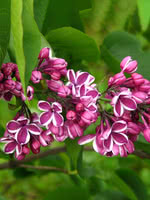Mon-Fri 9am - 5pm Mountain time
Black Cherry vs Sensation Lilac
Prunus serotina
Syringa vulgaris Sensation
NOT AVAILABLE THIS SEASON - MIGHT RETURN
Black Cherry is common in eastern North America but a rare find elsewhere. This tree is shade tolerant and is often found in old fields, forest openings, and along fencerows.
The fruit is edible and is commonly used to flavor rum and brandy. It is also edible and often eaten fresh or used in wine or jelly. Black Cherry trees typically begin producing fruit when they are 10 years of age.
Black Cherry wood is a rich reddish-brown color and is strong, making it valued in cabinetry and woodworking. It is often used in reclamation as well.
The leaves can poison livestock as they contain cyanide derivatives and precursors. However, many have noted that deer still seem to browse their trees with impunity and birds and other animals eat the fruit when available.
Sensation Lilac is an outstanding shrub known for its fragrant, bicolor flowers. In mid-spring, stunning purple flowers with white borders emerge and cover the entire plant.
Once the flowers bloom, they give off a beautifully sweet scent that is enjoyed by people, butterflies, hummingbirds, and other wildlife. Plant Sensation Lilac in full sun to produce the most vibrant flower color.
Black Cherry Quick Facts
Sensation Lilac Quick Facts
Toxicity: bark and wilted leaves toxic to livestock

